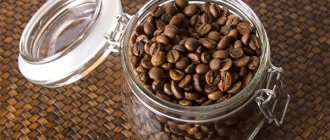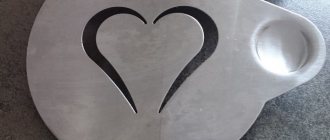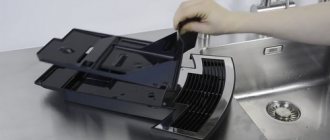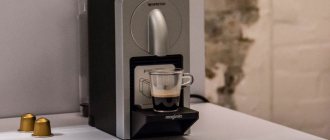Differences between submersible and stationary
There are only two main types of blenders: stationary and immersion. Both options have a number of characteristic features, advantages and disadvantages that should be taken into account during operation.
Submersible
Grinding in a submersible device causes certain difficulties. To grind coffee in such a blender, you need to select a container with a closing lid in advance. Only in this case, part of the powder will not spill out.
When using this grinding device, you will have to periodically pause the process, remove the moving part of the structure and remove small particles stuck in it.
Stationary
It is quite possible to grind coffee in a stationary device of compact size. It will be difficult to grind grains in a large device. They will simply scatter throughout the bowl. Accordingly, grinding will take a lot of time.
The stationary unit has a great advantage. It is equipped with a lid that prevents the resulting fractions from spilling. In addition, it is possible to use a pulse mode. Thanks to this, the operation of the system is periodically suspended, which means there will be time to shake the bowl and move the grains closer to the knives.
Can I use a blender?
The design of a blender is in many ways similar to a blade coffee grinder. The main difference is the location of the knives at a higher level. Therefore, during operation, some of the grains become clogged under them. You have to periodically pause the process, stir the mixture or shake the bowl so that the stuck grains begin to move again. Accordingly, the procedure causes certain difficulties.
You can use the blender as a coffee grinder if you plan to brew the drink in a Turkish coffee pot.
It will not be possible to grind coffee beans for a coffee maker, since this brewing method requires smaller fractions.
Manual grinding
If you have to decide how to grind your coffee beans, you can try the manual bean grinding method. Grind the fried beans in a mortar, meat grinder or hand mill, chop with a rolling pin or hammer, grind between 2 stones or using a knife blade. All these methods are ordinary and effective.
With all this, it is recommended to think in advance about the method of making the drink, because each of them requires its own type of grinding in order to obtain a product of the chosen strength, the desired taste and fragrant parameters, which has absorbed all the useful components and microelements. Grinding options may be as follows:
Large and hard are suitable for French press and geyser coffee maker, narrow, ultra-thin and powder are suitable for Turkish coffee, medium is considered universal.
Conclusion: you shouldn’t deny yourself the pleasure of preparing your favorite drink, even if you don’t have an electronic coffee grinder at home or it’s out of order. By experimenting with different methods of grinding beans and making coffee, you can gain new experience and compare the quality of the resulting drink with the usual one that has already become ordinary.
How to grind coffee without a coffee grinder?
There are several methods for grinding coffee without a coffee grinder or without a special coffee machine.
- To grind coffee, you can use a regular meat grinder. You need a certain attachment, which is usually used for spices, for example, for grinding black peppercorns. Obviously, the first time you won’t be able to make the grinding completely homogeneous. It will be necessary to pass the coffee through a meat grinder more than once before you achieve the desired result. If the meat grinder is electronic, it may work the first time.
- You can also use a blender to grind coffee.
- Coffee beans can be crushed using a more extreme method, using a hammer)). Wrap a few beans in newspaper and beat with a hammer until the coffee beans turn into powder.
It is important to remember that before grinding beans using these methods, you need to make sure that all parts of the equipment you use to grind coffee beans are well washed and do not have any foreign odors that could later negatively affect the smell of freshly prepared coffee. .
Manual methods
If there are no suitable mechanisms at hand or the electricity is turned off, then ordinary kitchen tools will help:
- mortar;
- rolling pin;
- hammer;
- big knife
Performing this operation with objects not suitable for this purpose requires caution. Be careful not to get injured.
Mortar
This kitchen accessory is sometimes used to grind small amounts of certain ingredients before cooking. Mortars are made from hardwood, ceramics, metal, and stone. They are convenient because they allow you to control the degree of grinding.
To grind coffee, use heavy tools made of stone or metal. Grinding sequence:
- A small amount of grains (1-2 tablespoons) is poured into the bowl.
- Using a pestle, pressing hard and turning, carefully grind each grain until large fractions are obtained.
- Large particles of coffee are crushed by crushing. To do this, apply short blows with a pestle.
- Crushing and grinding continue until a fine powder is obtained.
During chopping, with significant effort, there is a possibility of scratching the table surface. To prevent this from happening, place a piece of plastic or cutting board underneath.
rolling pin
A dough rolling tool will also help grind coffee beans in a pinch. In addition to the rolling pin, you will need a cutting board and a thick plastic bag. It would be good if there was a clasp on it.
A small amount of coffee is placed in a bag in one layer, which is placed on a cutting board. First, tap the rolling pin a little to break up the grains. And then they perform the same actions as when rolling out dough, only with more effort. If you try hard, you can get a medium or fine grind.
Hammer
Another alternative method is crushing with blows from a heavy object. You can grind coffee beans using a hammer. A cutting board is placed on the table. The grains are evenly placed in a thick plastic bag or between sheets of parchment paper. Everything is placed on a board and covered with a cloth or towel.
We take the instrument more comfortably in our hand. A kitchen hammer, mallet or, in extreme cases, a plumber's hammer will do. Grind with short, gentle blows until the desired fraction is obtained.
Knife
A large carving knife can also be used to crush coffee. To do this, the grains are placed on a cutting board and pressed on top with the flat side of the tool. The force is increased by placing the palm of your free hand on top. Moving from one group of grains to another, they gradually grind everything. The method is not easy, since not everyone has enough strength in their hands.
Is it possible to grind coffee in a blender?
Can coffee beans be ground in a blender? It should be said right away - yes. But there are many more pleasant and convenient devices for this process. After all, there is always the option of purchasing ready-made ground coffee.
Of course, there are situations in which grinding coffee in a blender is a necessary measure.
The coffee grinder broke, you accidentally bought a package of beans, you didn’t have the right unit at your dacha... Whatever happens, it’s important to know how to do it correctly. Grinding coffee in a kitchen appliance such as a blender has its own nuances
Knowing them, you can get a good result and not break your technique.
The blender itself is similar in design to a coffee grinder, the only difference being that the knives are located at a slightly higher level. It is for this reason that this kitchen appliance is not very suitable for grinding grains - they are small and clog under the knives. To ensure that the coffee is ground as evenly as possible, you need to shake the bowl periodically, and the process will continue. So a blender as a grain grinder is not the most convenient thing. Plus it takes longer.
You need to understand that the coffee will not be of sufficient quality in terms of grinding. It is unlikely that you will be able to obtain the required size if it concerns fine or superfine grinding. Also, the final powder is not suitable for brewing in a coffee machine. But the Turk, cezve, French press and cup are quite suitable as cooking methods.
And yet, how to grind coffee in a blender? What you need to know:
- It is worth making sure that the blender bowl is dry and clean. Moisture is the enemy of grains. And foreign odors and, especially, food particles will spoil the taste of the drink;
- The lid will save you from endless cleaning of grains and their fragments from all over the kitchen;
- Count the number of blades in the blender. For effective grinding you need 4 double knives;
- During the process, the grains are heated. And the powder does it even faster. Therefore, as with a coffee grinder, you need to take breaks during grinding to allow the knives to cool. Otherwise, the drink itself will have a burnt taste;
How to prepare a blender for processing coffee beans?
Now it’s worth talking about the preparatory stage. This is extremely necessary when performing this procedure. All the rules are extremely simple, understandable and do not have any special requirements. Here is a short list of them:
- Make sure that all equipment is in place. In particular, it is necessary that a lid be present. Otherwise, when you start grinding, the entire contents of the bowl will instantly scatter throughout the kitchen and end up on everything surrounding the work surface.
- After you wash the dishes before you start grinding, be sure to wipe everything with a dry cloth. Make sure there is no water left anywhere. Otherwise, the ground coffee will interact with the liquid and spoil.
- The last point in the instructions is about whether it is possible to grind coffee in a blender and how to do it correctly - if your kitchen appliances allow a choice of speeds, then try to process the beans at the lowest speed.
Rules for grinding grains
A blender is a universal device for mixing and grinding products; it has various attachments. If you really need it, grinding coffee in a blender is not difficult, you just need to know a few tricks.
- The bowl and knives must be dry and clean. Use only a container with a lid, otherwise the contents will scatter throughout the kitchen.
- Take a small bowl. The closer the grains are to the center, the finer the grind.
- The ideal option is a model with four sharp metal knives, otherwise the pieces will remain large.
- The product is poured in small portions. When grinding, use a low speed mode and low power of no more than 350 W. At high speeds, the knives will overheat and the coffee powder will acquire an unpleasant burnt smell.
- When operating, the device must be stopped and the bowl shaken to mix its contents.
Disadvantages of such grinding
Blender is a powerful device with 350-800 watts. A lower setting is needed to grind coffee. The grinding device also has other significant disadvantages:
- The grains are too hard, they damage the walls of the plastic bowl and dull the knives.
- The blender is not suitable for frequent grinding of beans. Its motor may burn out from overload.
- The knives in the device are located high and far from the walls of the bowl. The particles turn out to be large. They are not suitable for brewing a drink in a coffee machine.
Coffee grinder
Coffee grinders are manual and electric. In a manual coffee grinder, the mechanism is driven by your efforts. Electric coffee grinders operate on mains power.
A coffee grinder is designed to grind coffee. They come in two types: millstone and knife.
In knife grinders, coffee is ground by rapidly rotating sharp knives. The power of the device determines how finely the coffee will be ground. But they are not made particularly powerful, because at a very high rotation speed the coffee can heat up, which will give the final product a burnt taste and smell. This is not acceptable for coffee. Therefore, to make coffee as fine as possible, you need to grind it longer. Knife coffee grinders are great for those who like to brew coffee in a Turk.
blade coffee grinder
Burr grinders are coffee grinders in which coffee is placed between two metal plates and they grind it like the millstones of a mill. Such devices allow you to grind coffee finer and have an adjustable grind level; expensive models have about 14 of them. Coffee ground in such a coffee grinder is excellent for making lattes, espresso, and macchiato. In other words, coffee from a burr grinder is great for making coffee in a coffee machine or coffee maker.
It is not uncommon for a coffee grinder to be considered as a tool for grinding other products, such as sugar, nuts, and spices. Grinding other products is possible, but not recommended. Since grinding other products can lead to equipment damage. For example, the sugar begins to melt and is very difficult to remove from the blades and axle. And small particles and the smell of spices will negatively affect the ground coffee after this. But some coffee grinders come with special attachments for grinding spices.
Differences between submersible and stationary
There are only two main types of blenders: stationary and immersion. Both options have a number of characteristic features, advantages and disadvantages that should be taken into account during operation.
Submersible
Grinding in a submersible device causes certain difficulties. To grind coffee in such a blender, you need to select a container with a closing lid in advance. Only in this case, part of the powder will not spill out.
When using this grinding device, you will have to periodically pause the process, remove the moving part of the structure and remove small particles stuck in it.
Stationary
It is quite possible to grind coffee in a stationary device of compact size. It will be difficult to grind grains in a large device. They will simply scatter throughout the bowl. Accordingly, grinding will take a lot of time.
The stationary unit has a great advantage. It is equipped with a lid that prevents the resulting fractions from spilling. In addition, it is possible to use a pulse mode. Thanks to this, the operation of the system is periodically suspended, which means there will be time to shake the bowl and move the grains closer to the knives.
What kind of coffee grinders are there?
Coffee grinders are divided into:
Rotary (rotary) or knife, as they are also called.
Millstones.
Manual.
The first two varieties are electric, but their operating principles are different. The manual device is more reliable, but requires time and effort to grind the products. It is very difficult to grind coffee beans by hand - you need the coffee grinder to have a comfortable handle and not cause calluses during daily use.
Important! Coffee grinders are designed for coffee beans, so you can grind other products in them with great care, following the instructions. If the device is under warranty, the service will refuse to repair it for free, since the user himself caused damage to the electrical device.
Conclusion
Now you and I know for sure whether it is possible to grind coffee beans with a blender. Finally, a small conclusion:
- Use a hand blender . To grind coffee beans, it is better to use a simple hand blender to control the heating of the equipment. If the blender gets very hot, stop working for 15 minutes, then resume again.
- Maintain consistency . To avoid damage to the blender, operate it correctly - turn it on and off according to the instructions.
- Grind coffee beans on low power . Otherwise, the equipment will quickly wear out and fail.
Stationary device
Getting ready for work
If you had to grind coffee in a blender, use a stationary device with a small or narrow bowl. If the distance between the bottom, walls and knives is more than 5 millimeters, the grains will rarely fall under them and therefore will not be crushed.
Wash and dry all parts of the device. There should be no food residues or drops of water - this will spoil the taste and smell of the drink. Be sure to cover the bowl while working, otherwise the coffee beans will scatter throughout the kitchen.
Interesting! Mocha coffee variety - how it differs from the rest, the most popular varieties and roasts
Check the quality of the knives. To properly grind coffee, choose double ones with four blades. If there are fewer, you won't even get a coarse grind.
Step-by-step instruction
Grinding grains is possible only if you follow the rules:
- select the lowest power;
- pour 50 grams of grains;
- turn on the device for a minute, turn it off and stir the coffee mass;
- Allow the device to cool for 1-2 minutes and repeat the previous step.
It is better to use pulse mode. If the device is operated for more than 1 minute, it will begin to heat up. Because of this, the drink will acquire an unpleasant burnt taste.
The last step is to wash all parts of the device to eliminate the smell. With this grinder you will get large particles. If you need a fine powder, place the coffee mixture in a cloth or plastic bag and work it over with a rolling pin or hammer.
How to perform the procedure?
Now you can move on to the main part of the instructions, which gives an idea of whether it is possible to grind coffee in a Philips blender and how to do it correctly. The algorithm is quite simple and understandable:
- Load the coffee beans into the processing bowl.
- Cover with a lid and turn on medium speed.
- Start grinding the coffee beans for one minute.
- Turn off the blender, open the lid and stir the contents with a spoon.
- Take a break for five or ten minutes. After this, close the lid and resume the grinding procedure. Follow the indicated algorithm until you reach the desired consistency.
Features of a blender-coffee grinder
Many housewives use a blender as a replacement for other kitchen appliances (mixer, grater, meat grinder, coffee grinder). The main thing is not to overload the device and not to use it very often.
In order for the device to be able to grind coffee beans, it must have special mill attachments. This attachment allows you to grind not only coffee, but also sugar, cereals, nuts and other hard products, which adds versatility to the device.
Rules for grinding coffee in a blender
To get a high-quality starting product when using a blender as a coffee grinder, you must adhere to some rules:
It is important to ensure that there is a lid on the bowl where the coffee will be ground. Some immersion models do not come with special bowls with a lid (you won’t be able to grind coffee this way)
Properly wash the components of kitchen appliances after grinding grains
To ensure that the taste of the coffee does not transfer to other dishes, or vice versa, it is necessary to thoroughly clean the device after each use. To prevent coffee from having a burnt taste, grind the beans at low speed. The high power of the device can heat and scorch the grains, which will ruin its taste characteristics. From time to time it is necessary to shake the device while grinding so that the coffee is ground evenly. The degree of grinding depends on the operating time of the device, so if you need to grind the product to the state of flour, you will have to grind longer.
Using a Hand Blender
A special feature of a hand blender is that you can control the process yourself. A hand-held device immersed in a bowl should have an attachment with the sharpest and strongest knives. There shouldn’t be a lot of grains in the bowl, otherwise it will be more difficult to grab them
When grinding, it is important not to let the device heat up. It’s better to take short breaks (work for a minute, rest for a minute). If the device overheats, you must leave it alone for 15 minutes.
Small blades make it much more difficult to clean up coffee residue in a hand immersion blender.
If the device overheats, you must leave it alone for 15 minutes. Small blades make it much more difficult to clean up coffee residue in a handheld immersion blender.
Using a Stand Blender
A stationary blender is primarily designed for chopping soft foods. But special attachments with strong, sharp, double blades allow it to become a coffee grinder replacement
It is important to stir the contents from time to time while grinding or shake the bowl. Just like in an immersion blender, you must not overheat the mechanism. It is better to use at low or medium speed and take breaks from time to time
Grinding solid products should not be carried out frequently, as this will lead to malfunction of the device.
It is better to use at low or medium speed and take breaks from time to time. Grinding solid products should not be carried out frequently, as this will cause the device to malfunction.
Which blenders can grind coffee?
Such a unit can be submersible or stationary. In the first case, the model consists of a special handle on which attachments are attached. To grind food, you need to make an effort and immerse the blender in a container with food. It is equipped with small knives. They can handle coffee beans, but when grinding, you must periodically stop and clean the device thoroughly, otherwise it will not be able to continue working.
Important! When using an immersion blender, be sure to add a lid. Otherwise, food will begin to jump out of the bowl and fly around the room.
The stationary model has a special bowl and a tight-fitting lid. The knives are located at the bottom of the container. The equipment is installed on the platform and you can start working. You can also grind coffee with this blender. But the grinding will be uneven due to the fact that the knives cannot reach the bottom of the bowl.
You can use both blender options to grind coffee beans. The main thing is that the model is equipped with special mill knives.
Blender to help the resourceful housewife
Before you start grinding, you need to inspect the equipment. Firstly, the device must be equipped with a lid. If you grind coffee in a blender without a lid, you will have a long cleanup afterwards, since coffee beans will be everywhere, but not in the cup of the equipment. The second important aspect is the number of knives. To effectively grind hard coffee beans, you need at least 4 knives. Otherwise, the ground coffee particles will be quite large and will not be suitable for preparing a rich drink.
The blender must be clean and dry. Otherwise, the resulting product will be spoiled. After all, when moisture gets in, coffee loses its taste and aromatic properties. If the equipment has previously been used to grind other products, it must be washed so as not to catch food residues from the finished invigorating drink.
The blades in the blender are located high from the bottom of the bowl, so when grinding the grains will fall under the blades. To ensure sufficiently effective grinding, it is necessary to grind the grains at low speed, periodically stopping the equipment and lifting stuck grains from the bottom.
It is not advisable to use the machine for too long. When the blender is used for a long time, the blades heat up. Coffee absorbs all foreign odors and after grinding you may find that the drink has a burnt taste.
If the grains after grinding in a kitchen appliance turn out to be quite large in size, you can use a little trick. The resulting fraction must be placed in a cotton cloth, tied and further crushed with a hammer. You can use both a construction tool and a kitchen hammer designed for beating meat.
You can use a blender as a coffee grinder, but it is worth remembering that coffee beans have a very hard structure. If you regularly use the equipment for other than its intended purpose, you may lose the device. The blades in the blender are designed to grind soft food and bring it to a puree state. If you use this kitchen appliance every time to grind coffee beans, the knives will become unusable, they will become dull or deformed, and replacing them will cost a pretty penny.
Blender
Grinding coffee without a coffee grinder will not be difficult if you have a blender among your household appliances. It often comes with a grinder that allows you to achieve a medium grind size suitable for brewing in a coffee pot, French press or drip coffee maker.
Procedure:
- Pour no more than 100 g of coffee into the cup.
- Turn on the unit at short intervals, no more than 2-3 seconds.
- Shake the container periodically to ensure even grinding.
The chopper cannot be left on for long periods of time, as the rotating blades may overheat. Blenders, as a rule, are not designed for intensive work with solid products.
If the chopper is not included, then the immersion blender can be used separately. The beans are poured into a high-sided plastic cup and ground at low speed, pressing the knives against the surface of the coffee. In this case, you need to cover the container with a lid or hand so that the contents do not fly out.
A high-power stationary blender serves as a complete alternative to a coffee grinder. It must be turned on at more frequent intervals of 1-2 seconds. The grains in the unit will grind unevenly, so the container needs to be shaken vigorously from time to time. In this blender you can get medium-ground coffee in large volumes. Finally, the bowl and cutting parts must be thoroughly washed, adding a little soda to the detergent to get rid of the coffee aroma.
Tips for using a blender
The principle of working with it is quite simple and includes several useful tips. Among them:
- When preparing equipment for the procedure, try (if possible) to use attachments with the largest number of knives.
- Pour grains into the bowl of the device to such a level that they do not completely cover the part that will grind the food. If you overdo it, then pressed pieces will remain under the blades. And it is very difficult to get them. This applies to a hand blender.
- You need to grind coffee in a blender with some breaks so that the machine does not have time to overheat. Most often, waiting ten or fifteen minutes is enough.
- Considering the fact that this kitchen appliance was planned for processing soft products, using it as a coffee grinder is not recommended. But if this cannot be avoided, then it is necessary to use the unit for these purposes as little as possible.
What features should a suitable blender have?
Before you start processing coffee beans in such a non-standard way, it is worth familiarizing yourself with the main functions that can be useful when implementing this procedure. Here are the options available in modern kitchen blenders:
- Grinding. Using this option, you can cut various vegetables and fruits using different types of attachments.
- Mixing. Also a telling name. Allows you to prepare a homogeneous mass from a set of already crushed or previously ground products.
- Kolka. Actually, this is the function you should be interested in. It allows you to turn various solid products into fine powder. Examples include ice, nuts, and the coffee beans we need.
After we have clarified the question of whether it is possible to grind coffee in a blender, you can proceed to preparing the equipment.
Spice mill
The spice mill is designed for grinding spices. The design and volume of the mechanical unit are different, but this tool is usually not designed for large batches of product. In a mill you can grind a small amount of grains, which is enough for one brew. As in the case of a meat grinder, for better results the operation is repeated several times. The grind will be medium.
Hand mills are most often made of wood, which absorbs odors well. The aroma of spices is unlikely to spoil the coffee, but you will no longer be able to enjoy the pure taste of a rare type of Arabica or Robusta. In addition, after grinding flavored varieties, the mill will be very difficult to clean.
Disadvantages of using kitchen appliances:
- danger of overheating;
- failure of cutting parts;
- reduced service life;
- persistent odor that is difficult to get rid of.











